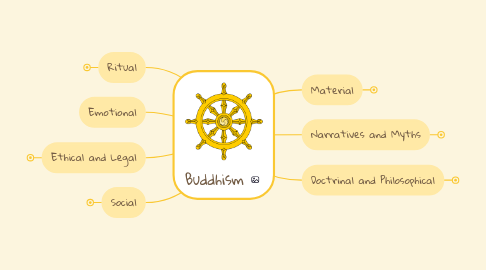
1. Ritual
1.1. Practices
1.1.1. The Three Jewels
1.1.1.1. I take refuge in the Buddha (The Example)
1.1.1.2. I take refuge in the Dharma (The Teaching)
1.1.1.3. I take refuge in the Sangha (The Community)
1.2. Ceremonies
1.2.1. Buddhist Ordination
1.3. Holy Days
1.3.1. Buddhist New Year
1.3.2. Vesak (Buddha Day)
1.3.3. Sangha Day (Magha Puja)
1.3.4. Vesak
1.3.5. Dhamma Day (Asalha Puja Day)
1.3.6. Observance Day (Uposatha)
1.3.7. Magha Puja
1.3.8. Kathina Ceremony (Robe Offering Ceremony)
1.3.9. Festival of Floating Bowls (Loy Krathong)
1.3.10. Elephant Festival
1.3.11. The Festival of the Tooth
1.3.12. Ancestor Day (Ulambana)
1.4. Protocols
1.4.1. Shoes are removed in the main shrine room
1.4.2. No head covering required
1.4.3. Practitioners generally sit on cushions on the floor. Chairs may be provided if needed
1.4.4. Discard chewing gum and candy before entering a temple
2. Emotional
3. Ethical and Legal
3.1. Golden Rule
3.1.1. “Treat not others in ways that you would find hurtful.”
3.1.2. “Treat not others in ways that you would find hurtful” Udana-Varga 5.18
3.2. The Four Noble Truths
3.3. The Eightfold Path
3.4. The Five Additional Precepts for Monks and Nuns
3.4.1. Abstain from eating at forbidden times
3.4.1.1. Untitled
3.4.2. Abstain from dancing and music
3.4.3. Abstain from adornment, perfumes, finery, etc
3.4.4. Abstain from using a high seat or bed
3.4.5. Abstain from accepting money
3.5. The Five Precepts of Lay Persons
3.5.1. Abstain from harming any living thing (practice kindness)
3.5.2. Abstain from stealing (practice genersosity)
3.5.3. Abstain from sexual exploitation (practice truthfulness)
3.5.4. Abstain from lying (practicing truthfulness)
3.5.5. Abstain from any mind altering substances (practicing awareness)
4. Social
4.1. Leadership
4.1.1. Monk
4.1.2. Nun
4.1.3. Abbot
4.2. Branches
4.2.1. Theravada (Way of the Elders)
4.2.1.1. Emphasis on self-effort; Key virtue is wisdom; prominence of monastics; minimizes metaphysics and ritual.
4.2.2. Mahayana (The Great Vehicle)
4.2.2.1. key virtue is compassion; prominence of laypersons; elaborates metaphysics and ritual.
4.2.3. Vajrayana Buddhism
4.2.4. Pure Land
4.2.4.1. Features Amitabha Buddha and other bodhisattvas (saints).
4.2.5. Zen
4.2.5.1. De-emphasizes scripture, ritual, philosophy; emphasizes meditation.
4.2.6. Zen
4.3. Population
4.3.1. 380 million (6% of world)
4.3.1.1. Thailand
4.3.1.2. China
4.3.1.3. Korea
4.3.1.4. Japan
5. Material
5.1. Places of Worship
5.1.1. Temple
5.1.1.1. Protocol
5.1.1.1.1. Shoes are removed in the main shrine room
5.1.1.1.2. No head coverings required
5.1.1.1.3. Practitioners generally sit on cushions on the floor. Chairs may be provided if needed.
5.1.1.1.4. Discard chewing gum and candy before entering the temple
5.2. Sacred Places
5.2.1. Lumbini
5.2.1.1. birthplace of Buddha
5.2.2. Bodh Gaya
5.2.2.1. (place of enlightenment)
5.2.3. Sarnath
5.2.3.1. (Location of first sermon)
5.2.4. Lhasa
5.3. Sacred Objects
5.3.1. Eight-spoked wheel
5.3.2. Buddhist Statue
6. Narratives and Myths
6.1. Founder
6.1.1. Siddhartha Gautama (Buddha)
6.2. Hero
6.2.1. Buddha
6.2.2. Dalai Lama
6.3. Scripture
6.3.1. Tripitaka
6.3.2. Dhammapada
6.3.3. Jataka Tales
7. Doctrinal and Philosophical
7.1. View on God
7.1.1. Non-theistic
7.2. Key Teachings
7.2.1. “Treat not others in ways that you would find hurtful.” -Udana-Varga 5.18
7.2.2. Golden Rule
7.3. Scriptures
7.3.1. Tripitaka
7.3.2. Dhammapada
7.3.3. Jataka Tales
7.3.4. Other
7.4. Key Teachings
7.4.1. The Eightfold Path
7.4.1.1. Right Understanding
7.4.1.1.1. Strive to understand clearly the Four Noble Truths and their implications in the working.
7.4.1.2. Right Thought
7.4.1.2.1. Think kindly of others and avoid dwelling on the past or future.
7.4.1.3. Right Speech
7.4.1.3.1. Speak kindly and thoughtfully. Be aware of the motives that prompt speech... why as well as how.
7.4.1.4. Right Action
7.4.1.4.1. Act kindly toward all living beings. Do not be attached to the results of actions.
7.4.1.5. Right Work
7.4.1.5.1. Have a vocation that does not harm others or is questionable. “The hand of the eye is subdued by the dye in which it works.”
7.4.1.6. Right Effort
7.4.1.6.1. Be determined and paced in cleansing the mind. (Ox stuck in the mud doesn’t relax until freed. Novice mountain climbers may be impatient with pace of the guide, but come to appreciate it later in the day.
7.4.1.7. Right Mindfulness
7.4.1.7.1. Be fully aware, always with concern for others. “All we are is the result of what we have thought.”
7.4.1.8. Right Concentration
7.4.1.8.1. Intensely concentrate during meditation to focus on being one with any situation. The mind is subject to the will.
7.4.2. The Three Jewels
7.4.2.1. I take refuge in the Buddha (The Example).
7.4.2.2. I take refuge in the Dharma (The Teaching).
7.4.2.3. I take refuge in the Sangha (The Community).
7.4.3. The Four Noble Truths
7.4.3.1. Dukkha: The Noble Truth of Suffering
7.4.3.1.1. All life is suffering (out-of-joint), full of sickness, anxiety, frustration, negativity, and unhappiness. Although there are passing pleasures, they vanish in time because of impermanence.
7.4.3.2. Samudaya: The Noble Truth of Cause of Suffering
7.4.3.2.1. Suffering is caused by Tanha, desire, greed, craving, self-centeredness and clinging to things in ignorance of their impermanence. Tanya is never satisfied.
7.4.3.3. Nirodha: The Noble Truth of The End of Suffering
7.4.3.3.1. It is possible to end suffering if one is aware of his or her own desires and puts an end to them. This awareness will open the door to lasting peace.
7.4.3.4. Magga: The Noble a Truth of the Path
7.4.3.4.1. By following the Eightfold Path, thinking and behavior is changed and a new awaking reached.
